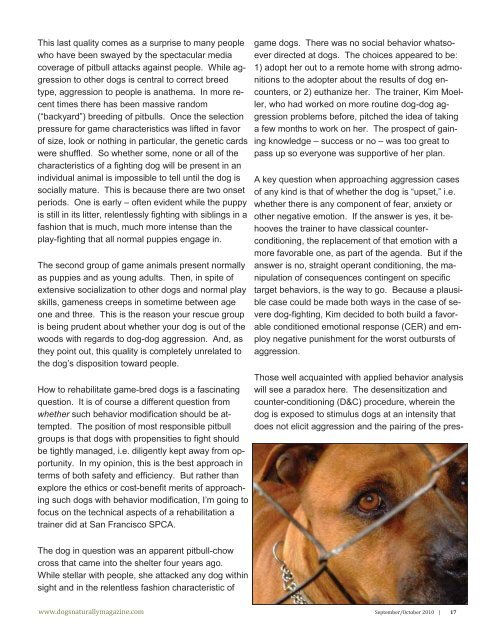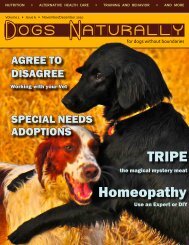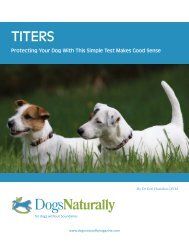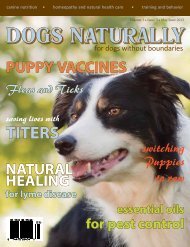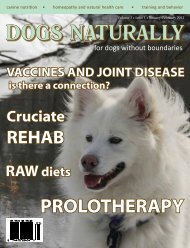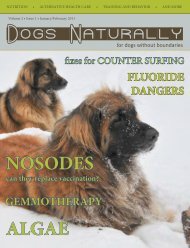September-October201.. - Dogs Naturally Magazine
September-October201.. - Dogs Naturally Magazine
September-October201.. - Dogs Naturally Magazine
Create successful ePaper yourself
Turn your PDF publications into a flip-book with our unique Google optimized e-Paper software.
This last quality comes as a surprise to many peoplewho have been swayed by the spectacular mediacoverage of pitbull attacks against people. While aggressionto other dogs is central to correct breedtype, aggression to people is anathema. In more recenttimes there has been massive random(“backyard”) breeding of pitbulls. Once the selectionpressure for game characteristics was lifted in favorof size, look or nothing in particular, the genetic cardswere shuffled. So whether some, none or all of thecharacteristics of a fighting dog will be present in anindividual animal is impossible to tell until the dog issocially mature. This is because there are two onsetperiods. One is early – often evident while the puppyis still in its litter, relentlessly fighting with siblings in afashion that is much, much more intense than theplay-fighting that all normal puppies engage in.The second group of game animals present normallyas puppies and as young adults. Then, in spite ofextensive socialization to other dogs and normal playskills, gameness creeps in sometime between ageone and three. This is the reason your rescue groupis being prudent about whether your dog is out of thewoods with regards to dog-dog aggression. And, asthey point out, this quality is completely unrelated tothe dog’s disposition toward people.How to rehabilitate game-bred dogs is a fascinatingquestion. It is of course a different question fromwhether such behavior modification should be attempted.The position of most responsible pitbullgroups is that dogs with propensities to fight shouldbe tightly managed, i.e. diligently kept away from opportunity.In my opinion, this is the best approach interms of both safety and efficiency. But rather thanexplore the ethics or cost-benefit merits of approachingsuch dogs with behavior modification, I’m going tofocus on the technical aspects of a rehabilitation atrainer did at San Francisco SPCA.game dogs. There was no social behavior whatsoeverdirected at dogs. The choices appeared to be:1) adopt her out to a remote home with strong admonitionsto the adopter about the results of dog encounters,or 2) euthanize her. The trainer, Kim Moeller,who had worked on more routine dog-dog aggressionproblems before, pitched the idea of takinga few months to work on her. The prospect of gainingknowledge – success or no – was too great topass up so everyone was supportive of her plan.A key question when approaching aggression casesof any kind is that of whether the dog is “upset,” i.e.whether there is any component of fear, anxiety orother negative emotion. If the answer is yes, it behoovesthe trainer to have classical counterconditioning,the replacement of that emotion with amore favorable one, as part of the agenda. But if theanswer is no, straight operant conditioning, the manipulationof consequences contingent on specifictarget behaviors, is the way to go. Because a plausiblecase could be made both ways in the case of severedog-fighting, Kim decided to both build a favorableconditioned emotional response (CER) and employnegative punishment for the worst outbursts ofaggression.Those well acquainted with applied behavior analysiswill see a paradox here. The desensitization andcounter-conditioning (D&C) procedure, wherein thedog is exposed to stimulus dogs at an intensity thatdoes not elicit aggression and the pairing of the pres-The dog in question was an apparent pitbull-chowcross that came into the shelter four years ago.While stellar with people, she attacked any dog withinsight and in the relentless fashion characteristic ofwww.dogsnaturallymagazine.com <strong>September</strong>/October 2010 | 17


